What’s in a word — describing LGBTQ+ collections
Emma Roache, Research Librarian at the Alexander Turnbull Library, writes about using Homosaurus — a set of peer-reviewed terms that describe our collections in inclusive, contemporary language that reflects the diversity of LGTBQ+ communities.
Introducing Homosaurus
The Alexander Turnbull Library is proud to say we are now using Homosaurus to help us describe new material joining the unpublished collections.
Homosaurus is a vocabulary of Lesbian, Gay, Bisexual, Transgender, and Queer (LGBTQ+) terms. It provides a peer-reviewed list of terms that we can draw from to describe the material we hold. Homosaurus is an approved word list, known as a thesaurus or controlled vocabulary. These make databases much easier to search.
We have many ways to describe concepts, so bringing all these terms together using an approved word or phrase makes searching in our databases more efficient. Once you identify the right term, using it will save you from having to search with synonyms.
LGBTQ+ communities are dynamic and diverse. The language we use for ourselves reflects this. Using a community-developed thesaurus will give us some assurance we are using relevant, contemporary language that accurately describes the communities. It will also help you find things in our collections by using terms that you are more familiar with.
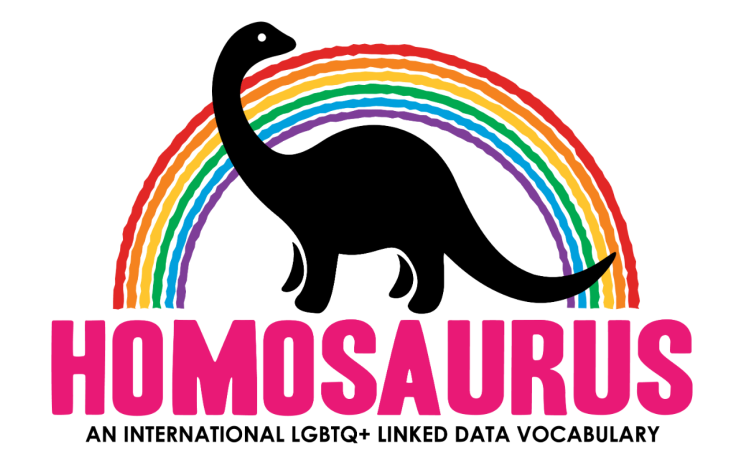
Homosaurus is an approved word list known as a thesaurus, of Lesbian, Gay, Bisexual, Transgender, and Queer (LGBTQ+) terms that we use to describe our collections in ways that are more inclusive and contemporary.
Why this change?
We have been looking for ways to incorporate more inclusive language when referring to communities that were previously described using derogatory or outdated terms, or not acknowledged at all.
The Library’s Authorities Review Group manages the terms and descriptions we use for our unpublished collections. We know some terms are racist, transphobic, and homophobic in our finding aid Tiaki. You may have used our finding aid and been surprised or upset to see such words describing diverse people and communities.
We aim to remedy some of those historic, harmful practices and to lessen the likelihood that you will find those offensive terms when you search our collections.
Why use these terms at all if they are outdated?
The library and archival community use standardised language for subject headings, genres, formats and other areas of our descriptive records. They are also known as thesauri or controlled vocabulary and they are an important part of the metadata that make up an item's descriptive record.
This is done so researchers are more assured of finding related material using the same term in different libraries and even different countries. It also means that library databases can link up using this metadata, and search platforms can look across multiple databases.
Here is an example on Te Puna Search. This database lets you look for books held by libraries in Aotearoa and libraries worldwide. In this search, we have found a list of titles held by libraries worldwide that use the Homosaurus heading ‘Non-binary people’.
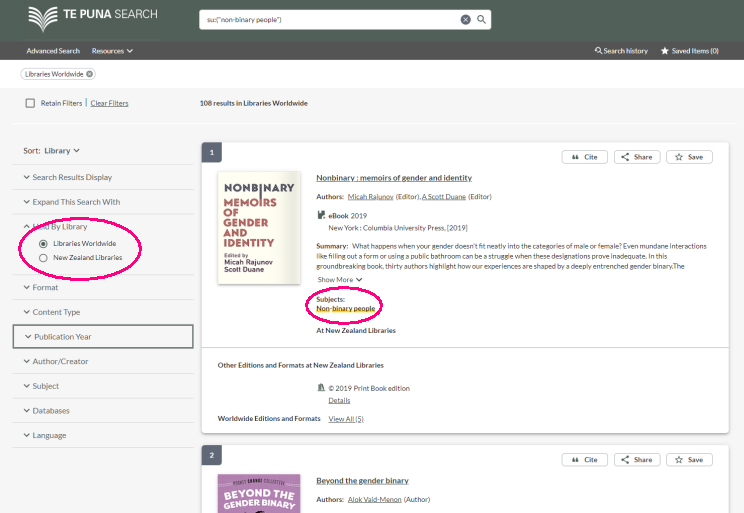
An example on Te Puna Search showing results of books held by libraries in Aotearoa and in libraries worldwide for a search using the Homosaurus heading ‘Non-binary people’.
In the Western world, thesauri were largely developed in the early twentieth century when it was common practice to use language we now consider harmful or outdated. These thesauri are often managed by large, slow-moving — possibly underfunded — institutions that may not employ staff from the communities represented in their collections. They can be slow to adapt to the changing social use of language.
The main thesaurus for subject headings used across libraries in English-speaking countries is the Library of Congress Subject Headings, known as LCSH.
Despite these issues, having a standardised language has many benefits. Generally, it is better to use these thesauri and lobby the agencies to update them or use other strategies to mitigate the problems.
The power of language
There is power in naming and classifying things. It is a way to control the world around us. Words can exclude people and create a stigma.
Libraries and archives are increasingly acknowledging that we are not neutral spaces. We are part of society and culture. Like other institutions, we have replicated the structural power systems of colonialism and cultural bias. There are lively professional debates in the library and archival worlds about who gets to choose what words we use.
A positive response to the idea of a single institution knowing the best way to describe everything and everyone is the development of community-led thesauri. A great example here is Ngā Upoko Tukutuku, te reo Māori subject headings developed by LIANZA, Te Rōpū Whakahau, and the National Library Te Puna Mātauranga o Aotearoa.
How will we use Homosaurus?
As well as terms related to gender and sexual orientation, the thesaurus has many terms related to sex, sex characteristics and sexuality that are not represented in LCSH.
We will consider using Homosaurus terms to describe our collections when we have:
material on gender, sexual orientation, sex, and sexuality
material that is about or from Lesbian, Gay, Bisexual, Transgender, Queer and Intersex (LGBTQ+) communities
relevant material in collections related to medical, legal and social justice areas. Consensual sex between men was illegal until 1986 in New Zealand. Homosexuality was classified as a mental illness by the medical profession until 1974, and until 2013 being non-binary was classified as a disorder and a pathology.
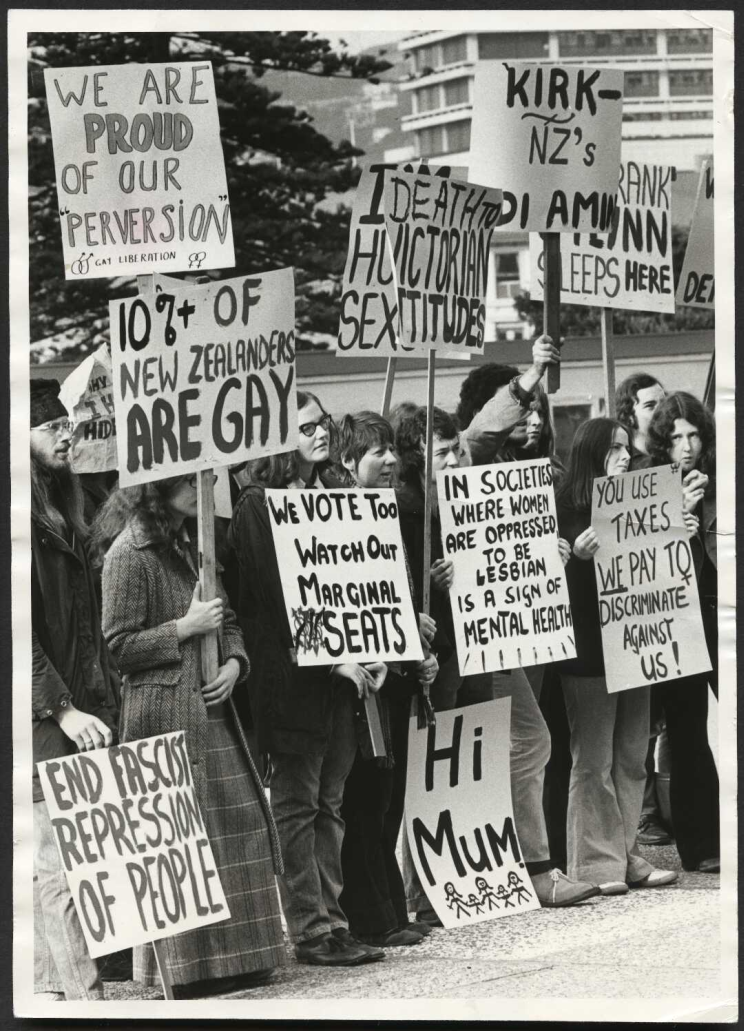
Members and supporters of the Gay Liberation Movement picketing Parliament in protest against the Government's failure to allow time for a private member's bill on homosexual law reform, 1974. Photographic negatives and prints of the Evening Post and Dominion newspapers. Ref: EP-Ethics-Demonstrations-Homosexual Law Reform-01. Alexander Turnbull Library.
We already have terms from LCSH that cover some of these areas. In practice, we will continue to use LCSH terms if they are still in social use and not offensive. The option of having Homosaurus encourages us to think more deeply about how we apply these terms.
In some cases, we will swap out LCSH terms for better Homosaurus terms. An example is the LCSH term Sexual minorities. LCSH offers this as an umbrella term for the diverse Rainbow communities. There are several problems with this. It conflates sexuality and gender. The use of the word “sexual” as an umbrella term has the effect of erasing trans and gender-diverse experiences.
And honestly, have you ever used the phrase “sexual minorities”? It’s just not a commonly known term.
So we moved to using the Homosaurus term LGBTQ+. It’s an umbrella term that works in a dynamic topic area and it is clear about what people it covers.
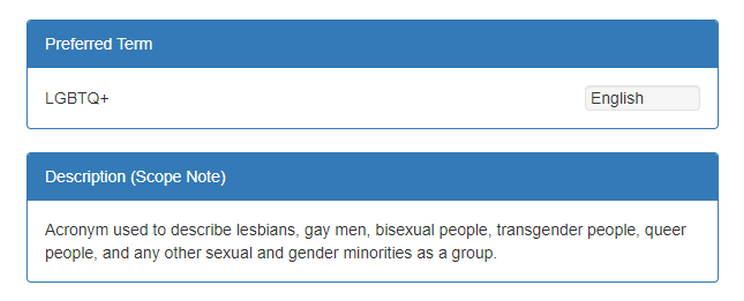
The Homosaurus page for the subject heading LGBTQ+ with scope note and broader and narrower terms. Homosaurus.org
What about historic use?
We will use the term the person or community uses for themselves.
Sometimes terms are no longer in social use but are still useful to describe collections and people in different times. Some terms may have been used more widely in the past, but now less so. One example is the term, Transsexuals.
Carmen Rupe (Ngāti Maniapoto, Ngāti Hauā, Ngāti Heke-a-Wai) was a drag queen entertainer, sex worker, entrepreneur, and LGBTQ+ icon. She referred to herself as a transsexual.

Carmen as a mayoral candidate for Wellington in 1977. Photographic negatives and prints of the Evening Post newspaper. Ref: 1/4-028324-F. Alexander Turnbull Library.
Our record for the photograph above was created using the LCSH term Transsexuals as a subject heading. Homosaurus includes the term Transsexual people, but cautions:
Some but not all people regard this term as outdated and offensive. Only use to describe people who self-identify as transsexual.
The strategy we will use here is to keep the LCSH term Transsexual applied to this record. The term reflects the person in their time. We will also add a more contemporary term to help you find this image of Carmen. You and other researchers today are more likely to know and use the word Transgender. So we will also apply the term for Transgender people, in this case.

A list of subject headings for the above photograph of Carmen, ref: 1/4-028324-F.
We recognise that Transsexual and Transgender identities are not the same or necessarily interchangeable. Here we follow guidance put together by the Trans Metadata Collective with their guide Metadata Best Practices for Trans and Gender Diverse Resources. We appreciate the work this group has put into this very practical document. It guides us towards good practice.
Acknowledging the past
It is important we retain the historic record of outdated or offensive terms. The social use of this language tells its own story of marginalisation and stigma.
We are careful to note on the record that we’ve made a change, when and why. You’ll see this indicated in the Processing Information field in a Tiaki record, which will note something like this, "Subject heading modified...".
In some cases, the outdated term may be removed from public view and recorded in a hidden field. With help from staff, interested researchers will still be able to find these terms and see how language about identity has changed over time. This is a valuable story for us to preserve.
Homosaurus does not yet appear in our open data
We make the records we create for all unpublished collections available to researchers as a downloadable file. This dataset is released under the New Zealand Government Open Access and Licensing Framework. Although we can now add Homosaurus terms to our internal subject list, and they are searchable in Tiaki, when you download the dataset you won’t see Homosaurus attributed as the source for a term. This will take a database enhancement to achieve. We don’t currently have a timeline for when this will happen.
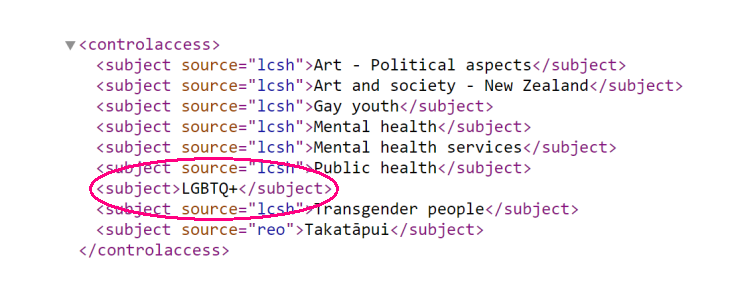
Although we can now add Homosaurus terms to our internal subject list, and these terms are searchable in Tiaki, when you download the open dataset you don't yet see Homosaurus attributed as the source for a term.
In this metadata example, you can see the attribution for Library of Congress Subject Headings (LCSH) and Ngā Upoko Tukutuku (reo). You can also see the term LGBTQ+ does not yet show as being from Homosaurus.
An ongoing project for us
It’s not going to be perfect. The beauty of having a regulated vocabulary is that it connects you to treasures and taonga described in words you may not have known to search with. The downside is these vocabularies can never keep up with our daily spoken language, which evolves fluidly and quickly.
The Alexander Turnbull Library was established in 1920. We have created over 950,000 records for unpublished material across these ten decades, starting with handwritten card catalogues and through several database migrations.

Reading room of the Alexander Turnbull Library, 11 Bowen Street, Wellington, during the 1930s. New Zealand Railways: Photographs. Ref: 1/1-003844-G. Alexander Turnbull Library.
Remediation can be time-consuming and technically difficult. We don’t have the capacity to systematically update older records to the standards we expect today. As we find issues we aim to address them. For smaller tasks, we may be able to remedy it quickly, and we may also make changes as part of longer-term projects.
If you find words in our records for unpublished collections that concern you, let us know by dropping us a line through our Ask a librarian service.
Interested in using Homosaurus?
If you are with a library or archive and are interested in using Homosaurus, you may want to see how and why other agencies are using it. This can help you assess the fit for your collections and communities.
Rachel Fisher, a librarian at a public library consortium in Illinois, has written up their rationale and experience of using Homosaurus. Some libraries have made announcements about how and why they are using Homosaurus, such as Princeton University Library and Emory University Libraries. And there are also research articles that explore more fully why Homosaurus is a useful tool to represent marginalised communities.
Homosaurus Board member Jay L. Colbert in his presentation “Cataloging with the Homosaurus: Who, What, When, Why, & How”, talks through how to apply Homosaurus subject headings to library materials. You can join the Homosaurus Google Group listserve HomoITCommunity where practitioners can share insights and ask questions. You can also get in touch directly with the Homosaurus team via their contact page.
We recommend the guidance from the Trans Metadata Collective, which looks at how to work with the limitations of LCSH. And look out for — or get involved with — work from the Queer Metadata Collective.